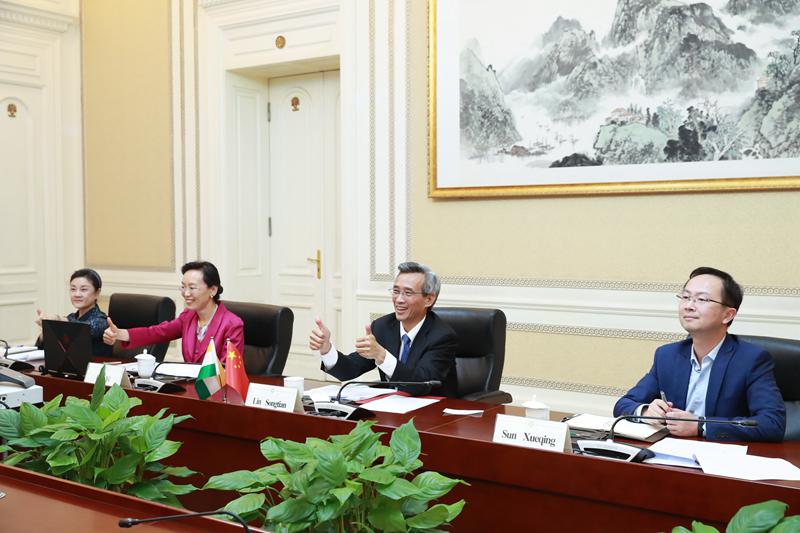

An online event was held on Oct. 10 to commemorate the 110th birth anniversary of Indian doctor Dwarkanath Kotnis who provided medical assistance in China during World War II.
The webinar, co-organized by the Chinese People’s Association for Friendship with Foreign Countries (CPAFFC) and the Centre for South Asian Studies of the Peking University, brought together teachers and students of universities in China and India to remember Dr. Kotnis’s contributions and discuss ways to carry forward his humanitarian spirit as well as to promote China-India friendship.

An online event was held on Oct. 10 to commemorate the 110th birth anniversary of Indian doctor Dwarkanath Kotnis. (Photo provided by CPAFFC)
Dr. Kotnis, born in 1910 in Mumbai, India, came to China as a member of the Indian Aid-China Medical Mission in 1938. In 1942, he joined the Communist Party of China and died in the same year due to epilepsy at the age of 32.
In order to carry forward the spirit of Dr. Kotnis, China and India established a joint medical mission in 2008, dispatching Chinese and Indian doctors to the other country to conduct voluntary services every year. A video shown during the event shared that, so far 103 outstanding young doctors from both countries have participated in the program.
This year marks the 70th anniversary of the establishment of diplomatic relations between China and India, with peace and harmony as the common aspiration of Chinese and Indian people, chairman of CPAFFC Lin Songtian said during his opening remarks.
“It is normal for neighbors to have occasional frictions, the important thing is to calm down and jointly seek solutions through friendly consultation,” said Lin, adding that both sides, as well as other Asian countries, should jointly guard against some external forces that stoke trouble and sow discord between China and other Asian countries at the expense of opportunities for common development of Asia.
Lin called upon youths of both countries to enhance cooperation and mutual understanding under the spirit of Dr. Kotnis, and jointly promote peace and prosperity of Asia.

Chinese and Indian teachers and students attend an online event on Oct. 10 to commemorate the 110th birth anniversary of Indian doctor Dwarkanath Kotnis. (Photo provided by CPAFFC)
Jiang Jingkui, professor of Indian Studies at the Peking University, said the current misunderstanding between the two countries is largely due to lack of communication.
“It is impossible for Chinese people to understand India through English and vice versa. There are nearly 800 million Indians speaking Hindi, the official language of India, while only 100 million speak English, with only 250,000 speaking English as a native language,” Jiang mentioned, noting that he is delighted to see at present a total of 17 universities in China teaching Hindi, which is a remarkable progress.
Jiang stressed the importance for both countries to seek common ground while shelving differences. “Though there are temporary difficulties, friendly relationship is permanent,” Jiang concluded.
Echoing Jiang, Vikash Singh, Indian expert at Beijing Foreign Studies University, said the current frictions between India and China will last only a short time, and the younger generations of China and India, especially Chinese youths learning Hindi and Indians learning Mandarin, play an important role to enhance mutual understanding between both countries.
“Youths should carry forward the humanitarian spirit of Dr. Kotnis and shoulder great responsibility to strengthen friendship between the two nations,” said Vikash.
“As a Chinese student learning Hindi, I will try my best to better understand our neighbor and tell China’s stories to India so as to make a contribution to the friendly exchanges between the two countries,” said Chai Jin, student at Xi’an International Studies University.

 Award-winning photos show poverty reduction achievements in NE China's Jilin province
Award-winning photos show poverty reduction achievements in NE China's Jilin province People dance to greet advent of New Year in Ameiqituo Town, Guizhou
People dance to greet advent of New Year in Ameiqituo Town, Guizhou Fire brigade in Shanghai holds group wedding
Fire brigade in Shanghai holds group wedding Tourists enjoy ice sculptures in Datan Town, north China
Tourists enjoy ice sculptures in Datan Town, north China Sunset scenery of Dayan Pagoda in Xi'an
Sunset scenery of Dayan Pagoda in Xi'an Tourists have fun at scenic spot in Nanlong Town, NW China
Tourists have fun at scenic spot in Nanlong Town, NW China Harbin attracts tourists by making best use of ice in winter
Harbin attracts tourists by making best use of ice in winter In pics: FIS Alpine Ski Women's World Cup Slalom
In pics: FIS Alpine Ski Women's World Cup Slalom Black-necked cranes rest at reservoir in Lhunzhub County, Lhasa
Black-necked cranes rest at reservoir in Lhunzhub County, Lhasa China's FAST telescope will be available to foreign scientists in April
China's FAST telescope will be available to foreign scientists in April